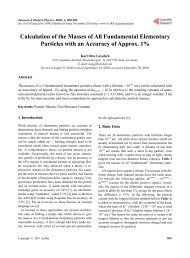In-gel digest (Coomassie stained) with trypsin - Proteomics
In-gel digest (Coomassie stained) with trypsin - Proteomics
In-gel digest (Coomassie stained) with trypsin - Proteomics
You also want an ePaper? Increase the reach of your titles
YUMPU automatically turns print PDFs into web optimized ePapers that Google loves.
Proteomic protocols for mass spectrometry<br />
<strong>In</strong>-<strong>gel</strong> <strong>digest</strong> (<strong>Coomassie</strong> <strong>stained</strong>) <strong>with</strong> <strong>trypsin</strong><br />
Adapted from:<br />
Shevchenko, A., Wilm, M., Vorm, O., and Mann, M. (1996) Mass spectrometric sequencing<br />
of proteins from silver <strong>stained</strong> polyacrylamide <strong>gel</strong>s. Anal. Chem. 68, 850-858.<br />
Chemicals:<br />
• NH4HCO3: M = 79 g/mol; 50mmol/l = 4mg/ml<br />
• Dithiothreitol (DTT): M = 154 g/mol; 10mmol/l = 1.54mg/ml<br />
• Iodacetamide (IAA): M = 185 g/mol; 55mmol/l = 10.2mg/ml<br />
• Trypsin: c = 20 – 25ng/µl (Promega)<br />
c = 5ng/µl (Roché)<br />
Excision of protein bands from polyacrylamide <strong>gel</strong>s<br />
• Wash the <strong>gel</strong> <strong>with</strong> water (2 changes, 10 minutes each)<br />
• Excise the spots of interest from the <strong>gel</strong>. Cut the excised piece into 1 mm-cubes. See<br />
general remarks.<br />
• Transfer to a 0.5 µl microfuge tube<br />
Washing of <strong>gel</strong> pieces<br />
• Wash the <strong>gel</strong> particles <strong>with</strong> water and 50 mM NH4HCO3/acetonitrile 1+1 (v/v) for 15 min<br />
• Remove all remaining liquid and add enough acetonitrile to cover the <strong>gel</strong> particles. The<br />
<strong>gel</strong> plugs shrink and stick together.<br />
• Remove the acetonitrile.<br />
• Rehydrate the <strong>gel</strong> pieces in 50 mM NH4HCO3.<br />
• After 5 min add an equal volume of acetonitrile.<br />
• Remove all liquid after 15 min of incubation.<br />
• Add enough acetonitrile to cover the <strong>gel</strong> particles.<br />
• After the <strong>gel</strong> pieces have shrunk remove the acetonitrile.<br />
• Dry down <strong>gel</strong> particles in a vacuum centrifuge.<br />
Reduction and alkylation<br />
• Swell the <strong>gel</strong> particles in 10 mM dithiotreitol/50 mM NH4HCO3 (freshly prepared).<br />
• <strong>In</strong>cubate for 45 min at 56°C.<br />
• Chill tubes to room temperature.<br />
• Remove excess liquid and replace it quickly by roughly the same volume as above of<br />
freshly prepared 55 mM iodoacetamide (light sensitive!) in 50 mM NH4HCO3.<br />
• <strong>In</strong>cubate for 30 min at room temperature in the dark.<br />
• Remove iodoacetamide solution.<br />
• Wash the <strong>gel</strong> particles <strong>with</strong> 50 mM NH4HCO3 and acetonitrile (1+1; v/v), one or two<br />
changes each, 15 min per change.<br />
• Add enough acetonitrile to cover the <strong>gel</strong> particles.<br />
• After the <strong>gel</strong> pieces have shrunk remove the acetonitrile.<br />
• Dry down the <strong>gel</strong> particles in a vacuum centrifuge.<br />
1<br />
Version 1.0, 6.12.2000
Proteomic protocols for mass spectrometry<br />
<strong>In</strong>-<strong>gel</strong> <strong>digest</strong>ion<br />
• Add just enough freshly prepared enzyme solution (in 25 mM NH4HCO3 ) to cover the<br />
<strong>gel</strong>.<br />
• <strong>In</strong>cubate at 37°C for 30 minutes.<br />
• Remove excess enzyme solution.<br />
• Add enough 25 mM NH4HCO3 (approx. 2-3µl) to keep the <strong>gel</strong> wet overnight, but avoid<br />
excess liquid.<br />
• <strong>In</strong>cubate at 37°C overnight.<br />
Extraction of peptides<br />
• Apply extraction buffer enough to cover the <strong>gel</strong> plugs completely, but avoid too much of<br />
excess volume (dilution of sample!). Support of the extraction by ultrasonication for a few<br />
minutes may improve the extraction yields. Recommended time frame for extraction:<br />
30min at room temperature.<br />
• The optimum composition of the extraction buffer will depend on the nature of the protein<br />
<strong>digest</strong>ed and on the aim of analysis respectively, and, to certain extent, on the MALDI<br />
preparation protocol you are going to use. For a number of applications, application of<br />
only one extraction buffer of a certain composition (ranging from 100/0 to 50/50 TF<br />
enough A 0.1% / ACN) may be sufficient, f.i. for many routine protein identification<br />
tasks. However, stepwise extraction using buffers of increasing ACN content may<br />
improve the overall sequence coverage achieved in the following MALDI-TOF analysis.<br />
Keep in mind also, that some prep protocols, f.i. Anchorchip Thin Layer (ACTL), require<br />
the absence of any organic solvent in the peptide solution. Applying this preparation<br />
protocol, you have the choice: either you extract using a buffer containing ACN, which<br />
forces you to remove it from the extract prior to MALDI preparation, or you avoid any<br />
ACN in the extraction buffer, which allows you to save the subsequent evaporation step,<br />
but may lead to a certain under-representation of those peptides which are less soluble in<br />
pure aqueous solvent.<br />
Mass spectrometric peptide analysis<br />
• If purification is necessary, perform ziptip or microcolumn purification. Alternatively,<br />
Anchorchip Thin Layer (ACTL) is a MALDI prep protocol, which is able to treat<br />
contaminated samples in a very efficient manner. Please refer to the Anchorchip manual<br />
in this matter.<br />
General remarks<br />
Size of <strong>gel</strong> pieces: Cut as close to the protein band as possible to reduce the amount of<br />
"background" <strong>gel</strong>. Avoid to use <strong>gel</strong> pieces much bigger than 1 mm x 1 mm.<br />
2<br />
Version 1.0, 6.12.2000
Proteomic protocols for mass spectrometry<br />
Excise a <strong>gel</strong> piece of roughly the same size from a non-protein containing region of the <strong>gel</strong> for<br />
use as a control.<br />
Solvent amounts: Unless otherwise specified all the solvent volumes used in the washing<br />
steps should roughly equal twice the <strong>gel</strong> volume.<br />
Solvent Purity: All solvent should be as pure as possible. Make sure that the bottles remain<br />
close when not in use.<br />
Lab materials purity: Scalpel, pipette tips and tubes should be clean. Use original Eppendorf<br />
tubes.<br />
Contamination by ceratin: Ceratin contamination should be avoided. Avoid ceratin to fall on<br />
the <strong>gel</strong>, in bottles or on pipette tips. It might help to use clean gloves (washed <strong>with</strong> water).<br />
Prepare the <strong>trypsin</strong> solution: Sequencing grade, modified <strong>trypsin</strong> is recommended. The<br />
solid powder is solved in 1 mM hydrochloric acid (for Roche Diagnostics, Mannheim <strong>trypsin</strong>)<br />
or 50 mM acetic acid (for Promega <strong>trypsin</strong>) giving a concentration of 100 ng/µl. Store 10 µl<br />
aliquots at -20°C.<br />
3<br />
Version 1.0, 6.12.2000


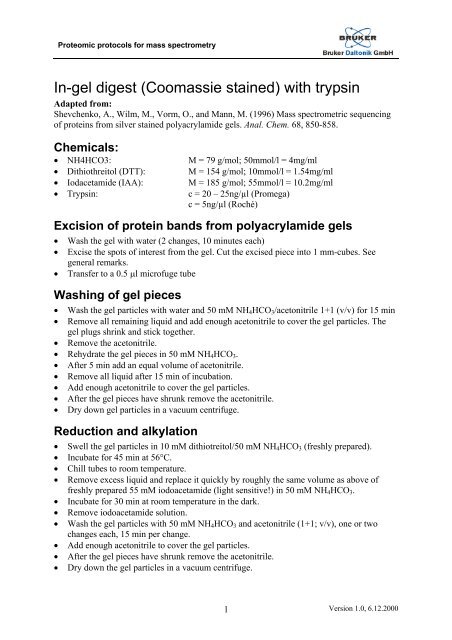

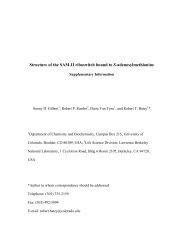

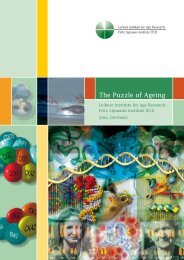

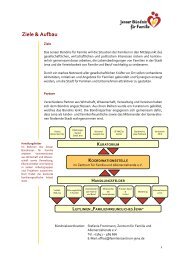



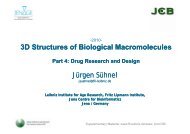
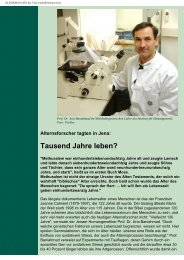

![Programm [pdf]](https://img.yumpu.com/20944039/1/184x260/programm-pdf.jpg?quality=85)
